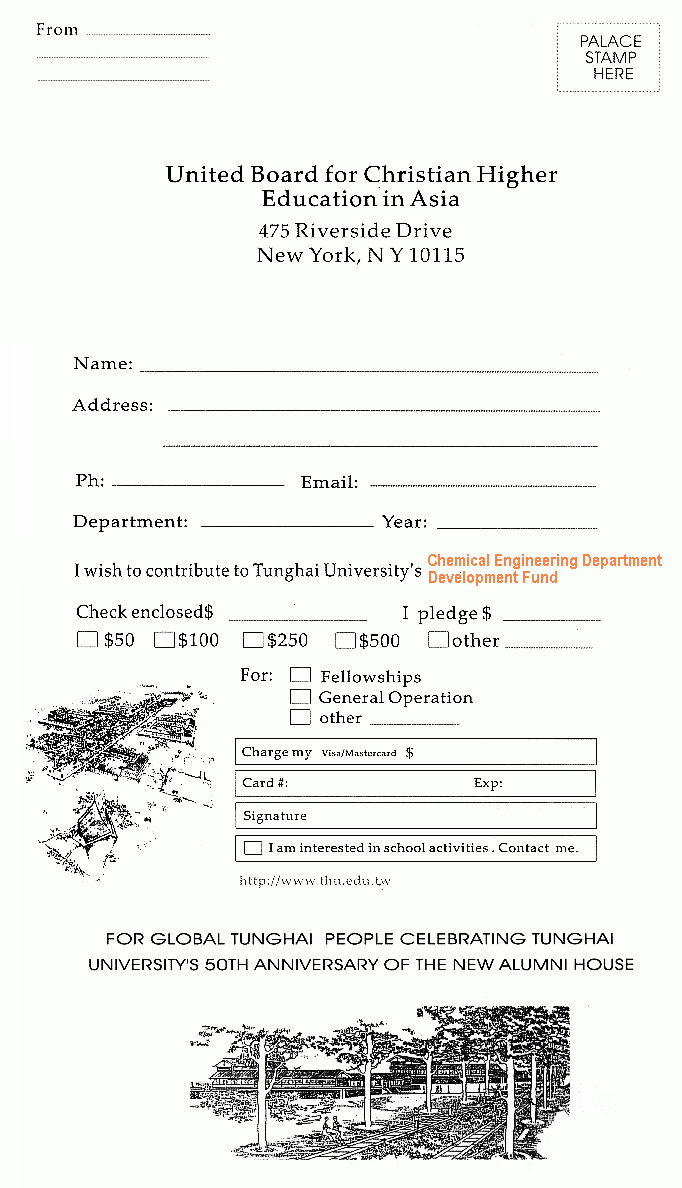|
Scanning
Electron Microscope Purchase Plan
Department of Chemical Engineering
Tunghai University
Taichung , Taiwan
9/21/2005
A. Background
In order make us more competitive and to meet the needs of our society, the
Department of Chemical Engineering at Tunghai is going to change its name to
the Department of Chemical and Materials Engineering in the near future. The
Department will expand the research areas to frontier materials, nano
technology, biological engineering, and opo-electronics. The key focus areas
in Material Engineering will be polymeric materials (e.g., polymer nano-composites
and liquid crystal polymers), electronic materials (e.g. opo-electronic
materials, electronic packing materials, battery materials) , surface
modification and nano-catalytic materials. We plan to add several courses in
the field of Material Engineering, including a course in Material
Engineering Experiment.
In order to provide adequate teaching/research environment, we need
facilities for micro- structure analyses (including SEM, TEM), mechanical
property testing (including tensile test, fatigue test, impact test and
dynamic test), polymer processing and analyses (extrusion machine, injection
machine, DSC, TGA, FTIR), electronic materials processing and measurements
(vacuum oven, vapor deposition equipments). We have enough facilities in
mechanical property testing and polymer processing / analyses . However, we
do not have adequate facilities in micro- structure analyses and electronic
materials processing / measurements. We plan to build up these facilities
gradually from the support of Tunghai University.
Tunghai University has allocated five million Taiwan dollars to our
Department for purchasing equipments to improve the facility in materials
engineering. Based on the decisions of our faculty meeting on 9/8/2005, we
decided to use the money to purchase a scanning electron microscope.
However, the money provided by the University is not enough to purchase the
equipment we need. Therefore, additional donations from our alumni for
supporting the equipment purchase are in great request.
B. The apparatus we plan to purchase
The apparatus we plan to purchase is a field emission scanning electron
microscope (abbreviated as FE SEM) equipped with an energy dispersive X-ray
spectrometer (abbreviated as EDS) and a wavelength dispersive X-ray
spectrometer (abbreviated as WDS).
Among various tools for material characterization, scanning electron
microscope (abbreviated as SEM) is the one most frequently used. SEM has
become the essential and required equipment for any department of materials
science and engineering.
The image of SEM can provide information about surface morphology of the
materials. With the use of modern field emission (abbreviated as FE)
electron gun, the resolution of FE-SEM can reach 1 nm. The ultra high
resolution FE-SEM is suitable for the observation of fine structures such as
multi-layered film and nano particles fabricated by the nano technology.
There are several additional parts available which can expand the high
resolution FE SEM to high performance analytical FE SEM. The combination of
SEM and energy dispersive X-ray spectrometer (abbreviated as EDS) is
suitable for qualitative, semi-quantitative, and elemental map analyses in a
very small region. The addition of wavelength dispersive X-ray spectrometer
(abbreviated as WDS) will provide us high resolution, full quantitative
elemental analysis of material surface, which is very useful for the
determination of composition distribution on the material surface.
The FE SEM (JEOL JSM-7000 Field Emission Scanning Electron Microscope) with
EDS (INCA Energy 350 Microanalysis System) +WDS (INCA WAVE 500 System) will
cost thirteen million Taiwanese dollars. Except the five million dollars
provided by Tunghai University, we need to raise additional eight million
dollars for the SEM purchase plan.
C. SEM users among our faculty
Ten faculty members in our department need FE SEM for their researches. The
following table lists the purposes and the time needed for each individual
(names are listed in alphabetical order).
|
Professor's Name |
Purposes
in using SEM |
Time needed
(hours/ year) |
Prof.
Chang,
You-Im |
To observe
the dispersion behaviors of colloid particles, Brownian particles, and nano-colloids.
|
100 |
Prof.
Chiao,
Shu- Min |
To
characterize the interfacial properties of composite materials. |
200 |
|
Prof.
Do,
Jing-Shan
|
To characterize the surface properties of optoelectronic
materials, battery materials,
sensor materials ,capacitor materials, and cathodic materials in fuel cell.(detailed
descriptions attached). |
200 |
Prof.
Gu,
Yesong |
To characterize the
surface properties of biosensors , drug carriers, bio-membranes,
and human tumor cells. (detailed descriptions attached). |
80 |
Prof.
Ho,
Chin-Sung |
To characterize
the surface properties and thickness of thin films. |
200 |
Prof.
Li,
Kuo-Tseng |
To
characterize the surface morphology , composition, particle sizes, crystal
structure of solid catalysts, nano-catalysis materials, crystalline polymers,
and carbon nanotubes. |
200 |
Prof.
Wang
Yeh |
To
characterize the surface morphology and dispersions of particulate
polymer composites. |
200 |
Prof.
Yang,
Fan-Chiang |
To observe the morphology
and structure of microorganisms , bacteria, and cells. (detailed descriptions attached) |
50 |
Prof.
Yang,
I-Kuan |
To observe the morphology
and structure of liquid crystalline polymers and nano-composite
polymer materials. (detailed descriptions attached) |
200 |
Prof.
Yen,
Hom-Wei |
To observe the morphology
of drug particles and bioactive materials. |
50 |
D. SEM Maintenance and Management
According to the information provided by the SEM supplier, the span of SEM
life is 20-30 years. The only maintenance we need is to change the pump oil
every half year. The SEM will be located in the ChE building, operated by a
trained technician, and supervised by the chairman of the Department.
|
 Department of Chemical Engineering
Department of Chemical Engineering